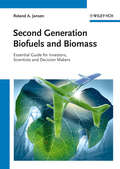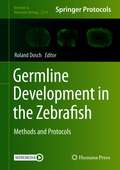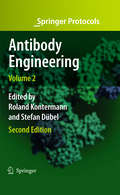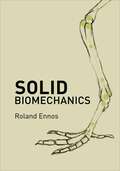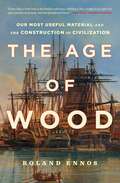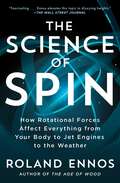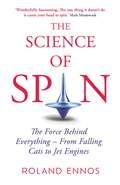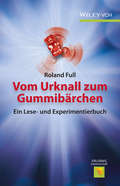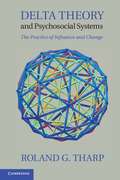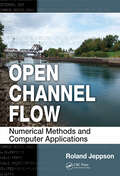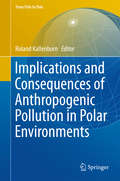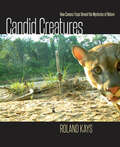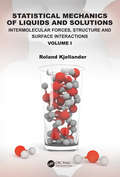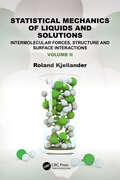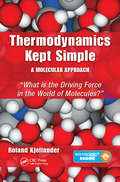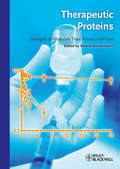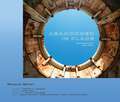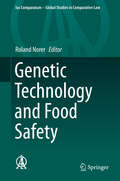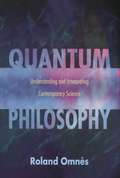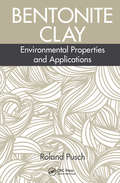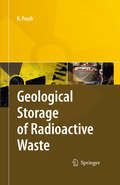- Table View
- List View
Second Generation Biofuels and Biomass
by Roland A. JansenThis guide to investing in the bioenergy market covers the topic from both a scientific, economic and political perspective. It describes the increasing number of second generation biodiesel projects which are now emerging in anticipation of growing sustainability concerns by governments, and in response to market demands for improved process efficiencies and greater feedstock production yields. The book also closely examines the science and technology involved in second generation biofuels and gives concrete examples, such as in the aviation industry. The result is an essential guide for scientists, investors, politicians and decision-makers in the energy sector.
Funktions- und Reglersynthese auf der Basis lokaler Modellnetze
by Roland ClaußDer Autor untersucht eine Methode zur Realisierung modellbasierter Funktionsentwicklung im industriellen Umfeld und der damit einhergehenden zeitlichen Ristrektionen eines Entwicklungsprojekts. Der Schwerpunkt liegt dabei auf der Systemidentifikation (datenbasierten Modellbildung) statischer oder dynamischer nichtlinearer Systeme, die auf der Basis lokaler Modellnetze realisiert wird. Für die Strukturoptimierung der Modellnetze werden zwei neue Ansätze vorgestellt, die eine hohe Effizienz und Genauigkeit bei der Modellbildung aufweisen. Der Autor integriert im nächsten Schritt die identifizierten Modelle in verschiedene beschränkte prädiktive Mehrgrößenregler eines Wärmepumpensystems und zeigt eine Strategie auf, um das System im geschlossenen Regelkreis effizient auszulegen und zu validieren.
Germline Development in the Zebrafish: Methods and Protocols (Methods in Molecular Biology #2218)
by Roland DoschThis volume details a wide range of methods, ranging from beginner through advanced, used to further study zebrafish and fish germline.. Chapter guide readers through cultivating and manipulating germ cells, imaging of germline processes and the molecular analysis of their, protein, and RNA. Written in the highly successful Methods in Molecular Biology series format, chapters include introductions to their respective topics, application details for both the expert and non-expert reader, and tips on troubleshooting and avoiding known pitfalls. Authoritative and cutting-edge, Germline Development in the Zebrafish: Methods and Protocols aims to ensure successful results in the further study of this vital field.
Antibody Engineering Volume 1 (Springer Laboratory Manual Ser.)
by Roland E. Kontermann Stefan DübelAntibodies are indispensable tools for research, diagnosis, and therapy. Recombinant approaches allow the modification and improvement of nearly all antibody properties, such as affinity, valency, specificity, stability, serum half-life, effector functions, and immunogenicity. "Antibody Engineering" provides a comprehensive toolbox covering the well-established basics but also many exciting new techniques. The protocols reflect the latest "hands on" knowledge of key laboratories in this still fast-moving field. Newcomers will benefit from the proven step-by-step protocols, which include helpful practical advice; experienced antibody engineers will appreciate the new ideas and approaches. The book is an invaluable resource for all those engaged in antibody research and development.
Solid Biomechanics
by Roland EnnosSolid Biomechanics is the first book to comprehensively review the mechanical design of organisms. With a physical approach and a minimum of mathematics, the textbook introduces readers to the world of structural mechanics and sheds light on the dazzling array of mechanical adaptations that link creatures as dissimilar as bacteria, plants, and animals. Exploring a wide range of subjects in depth, from spider silks and sharkskin to climbing plants and human food processing, this immensely accessible text demonstrates that the bodies of animals and plants are masterpieces of engineering, enabling them to survive in a hostile world. The textbook describes how organisms construct materials from limited components, arrange materials into efficient structures that withstand different types of stresses, and interact mechanically with their environment. Looking at practical and historical aspects of the subject, the book delves into how the mechanics of organisms might be applied to other engineering scenarios and considers the ways structural biomechanics could and should develop in the future if more is to be learned about the form and function of organisms. Solid Biomechanics will be useful to all those interested in how organisms work, from biologists and engineers to physicists and students of biomechanics, bionics, and materials science. The first comprehensive review of the structural mechanics of organisms Introduces the subject using a physical approach involving minimal mathematics Three complementary sections: materials, structures, and mechanical interactions of organisms Links the dazzling array of mechanical adaptations seen in widely differing organisms Practical and historical approach shows how mechanical adaptations have been discovered and how readers can perform their own investigations
The Age of Wood: Our Most Useful Material and the Construction of Civilization
by Roland EnnosA &“smart and surprising&” (Booklist) &“expansive history&” (Publishers Weekly) detailing the role that wood and trees have played in our global ecosystem—including human evolution and the rise and fall of empires—in the bestselling tradition of Yuval Harari&’s Sapiens and Mark Kurlansky&’s Salt.As the dominant species on Earth, humans have made astonishing progress since our ancestors came down from the trees. But how did the descendants of small primates manage to walk upright, become top predators, and populate the world? How were humans able to develop civilizations and produce a globalized economy? Now, in The Age of Wood, Roland Ennos shows for the first time that the key to our success has been our relationship with wood. &“A lively history of biology, mechanics, and culture that stretches back 60 million years&” (Nature) The Age of Wood reinterprets human history and shows how our ability to exploit wood&’s unique properties has profoundly shaped our bodies and minds, societies, and lives. Ennos takes us on a sweeping journey from Southeast Asia and West Africa where great apes swing among the trees, build nests, and fashion tools; to East Africa where hunter gatherers collected their food; to the structural design of wooden temples in China and Japan; and to Northern England, where archaeologists trace how coal enabled humans to build an industrial world. Addressing the effects of industrialization—including the use of fossil fuels and other energy-intensive materials to replace timber—The Age of Wood not only shows the essential role that trees play in the history and evolution of human existence, but also argues that for the benefit of our planet we must return to more traditional ways of growing, using, and understanding trees. A brilliant blend of recent research and existing scientific knowledge, this is an &“excellent, thorough history in an age of our increasingly fraught relationships with natural resources&” (Kirkus Reviews, starred review).
The Science of Spin: How Rotational Forces Affect Everything from Your Body to Jet Engines to the Weather
by Roland EnnosA clear and captivating work of popular science that explains rotational force—a basic driver of the universe affecting everything from the cosmos to our own bodies—from the masterful author of The Age of Wood.From the time women first used rotating bobbins to twist thread and men whirled slings around their heads to throw stones, people have found spin fascinating and baffling in equal measure. Now, in The Science of Spin, Roland Ennos shows how rotational motion dominates the workings of the world around us. It has shaped the solar system, galaxies, and black holes. It controls our climate and weather—from the pattern of trade winds through to the local formation of hurricanes and tornadoes. Harnessing the power of spin helped launch civilization, from the first developments of the wheel to the systems that now power the industrial world—propellers, turbines, centrifugal pumps, and electric motors. Even our own bodies are complex systems of rotating joints and levers. But scientists have a tendency to ignore the simple and straightforward. So, 17th-century scientists developed the science of mechanics to explain the phenomenon of the orbit of the planets rather than how machines work. And Newton&’s laws have actually limited our understanding of spin because they focus on linear motion rather than on an intuitive grasp of rotation. As a result, few people realize how spin makes our planet habitable, or how it has been tamed by engineers to make our lives more comfortable. In a lively and engaging style, Ennos presents a new approach to mechanics that not only helps us better understand the world, but also reveals unlikely links between tightrope walkers and tyrannosaurs, catapults and tennis players, stunt cars and long jumpers. By opening our minds, he shows how we can all learn to move about more gracefully, play sports more successfully and safely—and ensure that, like cats, we always land on our feet. A highly entertaining and informative read, whether it be natural or engineered, spin is what really makes the world go round.
The Science of Spin: The Force Behind Everything – From Falling Cats to Jet Engines
by Roland EnnosWhy exactly is the Earth round? How is it that boomerangs can turn in mid-air? And why do cats always land on their feet? From the solar system to spinning tops; hurricanes to hula hoops; powerplants to pendulums, one mysterious force shapes almost every aspect of our lives. A force which, despite its ubiquity, continues to confound, baffle and surprise. Artfully moving between astrophysics and anthropology, The Science of Spin provides a sweeping journey through space and time, from the creation of the Earth to the advent of the &‘fidget spinner&’. Charting the development of engineering and technology from the earliest prehistoric drills to the turbine engine, critically acclaimed author and scientist Roland Ennos presents a riveting account of human ingenuity and the seemingly infinite ways spin affects our daily lives.
Vom Urknall zum Gummibärchen (Erlebnis Wissenschaft Ser.)
by Roland FullEine außergewöhnliche Kombination aus Lese-, Wissens- und Experimentierbuch vom Urknall über die Entstehung des Lebens bis zum Menschen und seiner Kultur!
Delta Theory and Psychosocial Systems: The Practice of Influence and Change
by Roland G. TharpDelta Theory establishes the foundation for a true scientific applied psychology, a theory of how human influence induces change in others. Delta Theory is unified and universal, applying to all cultures, historical periods and goals for change. It integrates concepts and research from psychology, sociology, anthropology, evolution theory, philosophy, psychoneurology, cognitive science and cultural-historical-activity theory. Yet Delta Theory is clear, economical and elegant, with a full exposition of tactics for its practices. Rich examples are drawn from professional practices, but also from the creation and operations of criminals, healing ceremonies of indigenous peoples, and cross-species comparisons. This book ultimately seeks to describe how influence works, how it could be improved and how it can be resisted.
Biophysics: An Introduction (Springer Series In Biophysics Ser. #5)
by Roland GlaserBiophysics is the science of physical principles underlying all processes of life, including the dynamics and kinetics of biological systems.This fully revised 2nd English edition is an introductory text that spans all steps of biological organization, from the molecular, to the organism level, as well as influences of environmental factors. In response to the enormous progress recently made, especially in theoretical and molecular biophysics, the author has updated the text, integrating new results and developments concerning protein folding and dynamics, molecular aspects of membrane assembly and transport, noise-enhanced processes, and photo-biophysics. The advances made in theoretical biology in the last decade call for a fully new conception of the corresponding sections. Thus, the book provides the background needed for fundamental training in biophysics and, in addition, offers a great deal of advanced biophysical knowledge.
Heilende Magnete - strahlende Handys: Bioelektromagnetismus: Fakten und Legenden (Erlebnis Wissenschaft)
by Roland GlaserWhile the other works in the "Erlebnis Wissenschaft" series have concentrated on chemical substances in everyday life, this book brings to life a passionately debated physical phenomenon that has equally become an integral part of our lives - so-called electrosmog. The term itself is misleading from the start, such that an objective scientific treatment is urgently needed. The author is one of Europe's leading experts in the field.
Introduction to Animal Behavior
by Roland J. SiiterWith more emphasis than usual on the behavior of vertebrates and primates (although the author still includes classic bird and insect studies) the book examines how wild animals live, survive, and reproduce in their natural, wild habitats. This unique approach is presented in a straightforward manner without jargon, ensuring that students find the text informative and entertaining. Well-placed examples and explanations provide students with further opportunity to understand the application of the concepts.
Open Channel Flow: Numerical Methods and Computer Applications
by Roland JeppsonA comprehensive treatment of open channel flow, Open Channel Flow: Numerical Methods and Computer Applications starts with basic principles and gradually advances to complete problems involving systems of channels with branches, controls, and outflows/ inflows that require the simultaneous solutions of systems of nonlinear algebraic equations coupled with differential equations. The book includes downloadable resources that contain a program that solves all types of simple open channel flow problems, the source programs described in the text, the executable elements of these programs, the TK-Solver and MathCad programs, and the equivalent MATLAB® scripts and functions.The book provides applied numerical methods in an appendix and also incorporates them as an integral component of the methodology in setting up and solving the governing equations. Packed with examples, the book includes problems at the end of each chapter that give readers experience in applying the principles and often expand upon the methodologies use in the text. The author uses Fortran as the software to supply the computer instruction but covers math software packages such as MathCad, TK-Solver, MATLAB, and spreadsheets so that readers can use the instruments with which they are the most familiar. He emphasizes the basic principles of conservation of mass, energy, and momentum, helping readers achieve true mastery of this important subject, rather than just learn routine techniques. With the enhanced understanding of the fundamental principles of fluid mechanics provided by this book, readers can then apply these principles to the solution of complex real-world problems. The book supplies the knowledge tools necessary to analyze and design economical and properly performing conveyance systems. Thus not only is the book useful for graduate students, but it also provides professional engineers the expertise and knowledge to design well performing and economical channel systems.
Implications and Consequences of Anthropogenic Pollution in Polar Environments
by Roland KallenbornThe first evidence on the adverse effects of organic pollutants on Arctic ecosystems was provided by international research initiatives more than 30 years ago. Today, the indigenous people of the North are considered to be affected by exposure to persistent organic pollutants (POPs) and metals through their traditional marine food sources. The occurrence of pollutants of emerging concern in remote Polar environments is considered an essential criterion for prioritising this (largely neglected) type of contamination in national, international and global regulation schemes. Initiated during the first international Polar Years (IPY 2007-2009) and continued afterwards, 11 representative initiatives and projects are summarised as chapters in this book, which highlights today's interdisciplinary research on POPs in the Polar environment. The individual chapters describe in detail the consequences, priorities and perspectives of international research on POPs (legacy and emerging xenobiotics), its implications for regulations and scientific priorities including societal and cultural developments in the Arctic, as well as conservation priorities in Antarctica. This book is intended for all readers interested in learning more about modern research on environmental pollutants in the Polar environments (with a strong focus on Arctic environments). The impacts of pollution and climate change on Polar regions and the world as a whole will continue to be felt for many years to come. Sound science is, thus, vital in order to underpin actions that need to be taken at the global, regional and local levels. This book contributes to this highly relevant, interdisciplinary environmental scientific endeavour.
Candid Creatures: How Camera Traps Reveal the Mysteries of Nature
by Roland KaysA riveting collection of photographs that captures wild animals in their native habitats.In Candid Creatures, the first major book to reveal the secret lives of animals through motion-sensitive game cameras, biologist Roland Kays has assembled over 600 remarkable photographs. Drawing from archives of millions of color and night-vision photographs collected by hundreds of researchers, Kays has selected images that show the unique perspectives of wildlife from throughout the world. Using these photos, he tells the stories of scientific discoveries that camera traps have enabled, such as living proof of species thought to have been extinct and details of predator-prey interactions.Each image captures a moment frozen in the camera’s flash as animals move through their wild habitats. Kays also discusses how scientists use camera traps to address conservation issues, creating solutions that allow humans and wild animals to coexist. More than just a collection of amazing animal pictures, the book’s text, maps, and illustrations work together to describe the latest findings in the fast-moving field of wildlife research. Candid Creatures is a testament to how the explosion of game cameras around the world has revolutionized the study of animal ecology. The powerful combination of pictures and stories of discovery will fascinate anyone interested in science, nature, wildlife biology, or photography.
Statistical Mechanics of Liquids and Solutions: Intermolecular Forces, Structure and Surface Interactions
by Roland KjellanderThe statistical mechanical theory of liquids and solutions is a fundamental area of physical sciences with important implications for many industrial applications. This book shows how you can start from basic laws for the interactions and motions of microscopic particles and calculate how macroscopic systems of these particles behave, thereby explaining properties of matter at the scale that we perceive. Using this microscopic, molecular approach, the text emphasizes clarity of physical explanations for phenomena and mechanisms relevant to fluids, addressing the structure and behavior of liquids and solutions under various conditions. A notable feature is the author’s treatment of forces between particles that include nanoparticles, macroparticles, and surfaces. The book also provides an expanded, in-depth treatment of polar liquids and electrolytes.
Statistical Mechanics of Liquids and Solutions: Intermolecular Forces, Structure and Surface Interactions
by Roland KjellanderThe statistical mechanical theory of liquids and solutions is a fundamental area of physical sciences with important implications in other fields of science and industrial applications. Statistical Mechanics of Liquids and Solutions: Intermolecular Forces, Structure and Surface Interactions is the second in a series of two on this subject. While the first volume introduced equilibrium statistical mechanics in general and statistical mechanics of liquids and solutions at an introductory level, the present volume presents an advanced treatment of the subject and penetrates much deeper into liquid state theory.A major theme in both books is the intimate relationship between forces in a fluid and the fluid structure - a relationship that is paramount for the understanding of the subject of interactions in dense fluids. Using this microscopic, molecular approach, the text emphasizes clarity of physical explanations for phenomena and mechanisms relevant to fluids, addressing the structure and behavior of liquids and solutions under various conditions. A notable feature is the author's treatment of intermolecular interactions in liquids and solutions that include interactions between nanoparticles, macroparticles, and surfaces. The book provides an in-depth treatment of simple liquids, molecular fluids, particle dispersions, dense ionic fluids and electrolyte solutions with molecular solvent, both in the bulk and in confinement. It contains a unified exact treatment of electrolyte solutions, ionic liquids and polar fluids as well as approximate theories and applications.Statistical Mechanics of Liquids and Solutions will be an invaluable resource for graduate and postgraduate students in physics, chemistry, soft matter science, surface and colloid science and related fields, as well as professionals and instructors in those areas of science.
Thermodynamics Kept Simple - A Molecular Approach: What is the Driving Force in the World of Molecules?
by Roland KjellanderThermodynamics Kept Simple - A Molecular Approach: What is the Driving Force in the World of Molecules? offers a truly unique way of teaching and thinking about basic thermodynamics that helps students overcome common conceptual problems. For example, the book explains the concept of entropy from the perspective of probabilities of various molecula
Therapeutic Proteins: Strategies to Modulate Their Plasma Half-lives
by Roland KontermannFor this ready reference, the internationally renowned authority in the field, Roland Kontermann, has assembled a team of outstanding contributors from industry and academia to convey the worldwide knowledge on modifying therapeutic proteins in order to optimize their pharmacological potential. The result is a comprehensive work covering all approaches and aspects of the topic in one handy volume, making this indispensable reading for companies and research institutions working on the development of biopharmaceuticals.
Abandoned in Place: Preserving America's Space History
by Roland MillerStenciled on many of the deactivated facilities at Cape Canaveral Air Force Station, the evocative phrase &“abandoned in place&” indicates the structures that have been deserted. Some structures, too solid for any known method of demolition, stand empty and unused in the wake of the early period of US space exploration. Now Roland Miller&’s color photographs document the NASA, Air Force, and Army facilities across the nation that once played a crucial role in the space race.Rapidly succumbing to the elements and demolition, most of the blockhouses, launch towers, tunnels, test stands, and control rooms featured in Abandoned in Place are located at secure military or NASA facilities with little or no public access. Some have been repurposed, but over half of the facilities photographed no longer exist. The haunting images collected here impart artistic insight while preserving an important period in history.
Genetic Technology and Food Safety
by Roland NorerThe volume gives an overview on how legislators all over the world have come up with different legal solutions for governing genetically modified organisms (GMOs) and food security and provides a compact summary of the existing regulations in this field. In a comparative legal approach, a general report analyses and compares these various national and supranational legal systems. It closely follows the newest developments at the interface between genetic engineering law and food law. The emergence of a new technology usually leads to fundamental questions as to how the law should respond to it. The regulation of genetically modified organisms is a prime example, they have been discussed controversially ever since they were subject of legislation and regulation. In particular, this applies to the use of GMOs in food production. There is a variety of interesting legislations and a differentiated width of legal frameworks on international, supranational (EU) and national level to be found. The different regulations that thereby came to light are evidence of the various opinions and policies the societies and states have developed on this matter. It is this variety of regulations the volume examines, primarily on the basis of national reports that were handed in concerning the topic of genetic technology and food security at the occasion of the XIX International Congress of Comparative Law.
Quantum Philosophy: Understanding and Interpreting Contemporary Science
by Roland OmnèsIn this magisterial work, Roland Omnès takes us from the academies of ancient Greece to the laboratories of modern science as he seeks to do no less than rebuild the foundations of the philosophy of knowledge. One of the world's leading quantum physicists, Omnès reviews the history and recent development of mathematics, logic, and the physical sciences to show that current work in quantum theory offers new answers to questions that have puzzled philosophers for centuries: Is the world ultimately intelligible? Are all events caused? Do objects have definitive locations? Omnès addresses these profound questions with vigorous arguments and clear, colorful writing, aiming not just to advance scholarship but to enlighten readers with no background in science or philosophy. The book opens with an insightful and sweeping account of the main developments in science and the philosophy of knowledge from the pre-Socratic era to the nineteenth century. Omnès then traces the emergence in modern thought of a fracture between our intuitive, commonsense views of the world and the abstract and--for most people--incomprehensible world portrayed by advanced physics, math, and logic. He argues that the fracture appeared because the insights of Einstein and Bohr, the logical advances of Frege, Russell, and Gödel, and the necessary mathematics of infinity of Cantor and Hilbert cannot be fully expressed by words or images only. Quantum mechanics played an important role in this development, as it seemed to undermine intuitive notions of intelligibility, locality, and causality. However, Omnès argues that common sense and quantum mechanics are not as incompatible as many have thought. In fact, he makes the provocative argument that the "consistent-histories" approach to quantum mechanics, developed over the past fifteen years, places common sense (slightly reappraised and circumscribed) on a firm scientific and philosophical footing for the first time. In doing so, it provides what philosophers have sought through the ages: a sure foundation for human knowledge. Quantum Philosophy is a profound work of contemporary science and philosophy and an eloquent history of the long struggle to understand the nature of the world and of knowledge itself.
Bentonite Clay: Environmental Properties and Applications
by Roland PuschStudies the Environmental, Cosmetic, and Pharmaceutical Applications of Bentonite ClayBentonite clay, of which members of the smectite family of clay minerals are particularly important, has proven to be effective in sealing off wastes from groundwater. Bentonite Clay: Environmental Properties and Applications explores the mineralogy of clays in ge
Geological Storage of Highly Radioactive Waste
by Roland PuschThe book describes and assesses current concepts for long-term disposal of highly radioactive waste. Different types of rock are discussed and assessed with respect to practical difficulties in the construction of a repository, and the efficiency of isolating radioactive waste. Safety matters are most important and are treated in the respective chapters and in a final, conclusive chapter. Cost issues and related quality matters are discussed for the case of constructing a virgin repository and repositories in the form of converted abandoned mines.
